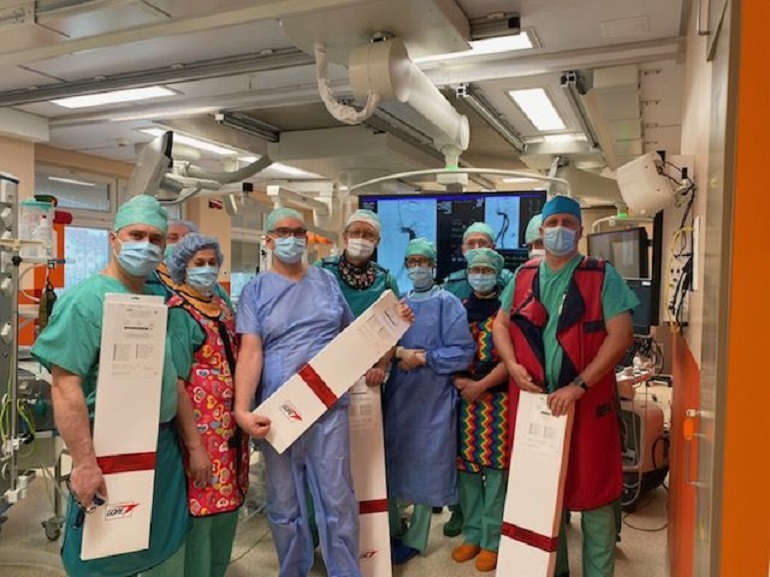First in Central Europe Procedure at University Hospital

The implantation procedure was carried out by the team: Prof. Grzegorz Oszkinis, Dr. Jacek Hobot and Dr. Robert Żurawel together with anaesthesiologists: Dr Rahim Said and Dr Dominik Jeziorny, the nursing team: Elwira Surminska, Joanna Machacka and Renata Perkowska, and technician Filip Zuczek.
The first procedure in Central Europe to implant the latest GORE® EXCLUDER® Conformable abdominal stent graft, a device for the repair of abdominal aortic aneurysms with severe neck angle, was performed at the University Hospital in Opole.
‘The GORE® EXCLUDER® Conformable stent graft used for the procedure is the latest and most advanced device for percutaneous repair of abdominal aortic aneurysms, explains Professor Grzegorz Oszkinis, head of the Vascular and General Surgery Ward at the UH.
‘It allows for the treatment of patients with aortic aneurysm having severe neck angle (over 60°) with a length of 10 mm, in whom so far the only treatment option was to perform a surgical operation. This device makes it possible to treat very difficult abdominal aortic aneurysms,’ emphasises Prof. Oszkinis.
Stent graft is a fabric tube, supported by a metal mesh, inserted into the aorta. The aim of the procedure is to strengthen the vessel wall or to make a new connection between vessels in order to prevent their further expansion. Once the stent graft is implanted, it is covered with a layer of cells and becomes an integral part of the vessel.
The implantation procedure in the operating hybrid room was carried out by the team: Prof. Grzegorz Oszkinis, Dr. Jacek Hobot and Dr. Robert Żurawel together with anaesthesiologists: Dr Rahim Said and Dr Dominik Jeziorny, the nursing team: Elwira Surminska, Joanna Machacka and Renata Perkowska, and technician Filip Zuczek.
‘An aortic aneurysm is a life-threatening condition of the circulatory system,’ says Prof. Oszkinis. ‘They do not cause characteristic clinical symptoms and are usually diagnosed accidentally and very often in an advanced stage. The natural history of an aortic aneurysm is its expansion over time, which eventually results in its rupture. Half of such patients die before reaching hospital, and of those who undergo an emergency surgery less than half survive. In contrast, the risk of death during a planned operation is ten times lower and amounts to about 5% - says the surgeon.
About 150 patients undergo surgery due to abdominal aortic aneurysms in the UH every year.
‘The analysis of the health map shows that the incidence of cardiovascular diseases in the next few years will be rising throughout the country and in the Opole Voivodeship faster than in other regions,’ points out Prof. Oszkinis.
The Opole team is one of the most dynamic and perfectly cooperating in preventing complications in patients with abdominal aortic aneurysms. ‘Despite the difficult situation associated with the SARS-CoV2 epidemic, the number of people operated on with a disease that is directly life-threatening is increasing. It is possible thanks to the broad cooperation of many specialists of the University Hospital,’ concludes Prof. Oszkinis.
Material: UH



